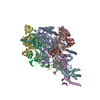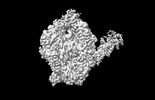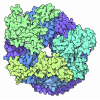[English] 日本語
 Yorodumi
Yorodumi- EMDB-16929: Cryo-EM structure of Pyrococcus furiosus transcription elongation... -
+ Open data
Open data
- Basic information
Basic information
| Entry |  | |||||||||
|---|---|---|---|---|---|---|---|---|---|---|
| Title | Cryo-EM structure of Pyrococcus furiosus transcription elongation complex bound to Spt4/5 | |||||||||
 Map data Map data | ||||||||||
 Sample Sample |
| |||||||||
 Keywords Keywords | RNA / Polymerase / Elongation complex / Pyrococcus furiosus / DNA / Archaea / TRANSCRIPTION | |||||||||
| Function / homology |  Function and homology information Function and homology informationtranscription elongation-coupled chromatin remodeling / translation elongation factor activity / transcription elongation by RNA polymerase I / tRNA transcription by RNA polymerase III / transcription by RNA polymerase I / DNA-directed RNA polymerase complex / regulation of DNA-templated transcription elongation / DNA-templated transcription initiation / ribonucleoside binding / DNA-directed RNA polymerase ...transcription elongation-coupled chromatin remodeling / translation elongation factor activity / transcription elongation by RNA polymerase I / tRNA transcription by RNA polymerase III / transcription by RNA polymerase I / DNA-directed RNA polymerase complex / regulation of DNA-templated transcription elongation / DNA-templated transcription initiation / ribonucleoside binding / DNA-directed RNA polymerase / DNA-directed RNA polymerase activity / transcription by RNA polymerase II / protein dimerization activity / structural constituent of ribosome / ribosome / nucleotide binding / mRNA binding / DNA-templated transcription / regulation of DNA-templated transcription / regulation of transcription by RNA polymerase II / magnesium ion binding / DNA binding / zinc ion binding / cytoplasm Similarity search - Function | |||||||||
| Biological species |   Pyrococcus furiosus DSM 3638 (archaea) Pyrococcus furiosus DSM 3638 (archaea) | |||||||||
| Method | single particle reconstruction / cryo EM / Resolution: 3.45 Å | |||||||||
 Authors Authors | Tarau DM / Reichelt R / Heiss FB / Pilsl M / Hausner W / Engel C / Grohmann D | |||||||||
| Funding support |  Germany, 1 items Germany, 1 items
| |||||||||
 Citation Citation |  Journal: Nucleic Acids Res / Year: 2024 Journal: Nucleic Acids Res / Year: 2024Title: Structural basis of archaeal RNA polymerase transcription elongation and Spt4/5 recruitment. Authors: Daniela Tarău / Felix Grünberger / Michael Pilsl / Robert Reichelt / Florian Heiß / Sabine König / Henning Urlaub / Winfried Hausner / Christoph Engel / Dina Grohmann /  Abstract: Archaeal transcription is carried out by a multi-subunit RNA polymerase (RNAP) that is highly homologous in structure and function to eukaryotic RNAP II. Among the set of basal transcription factors, ...Archaeal transcription is carried out by a multi-subunit RNA polymerase (RNAP) that is highly homologous in structure and function to eukaryotic RNAP II. Among the set of basal transcription factors, only Spt5 is found in all domains of life, but Spt5 has been shaped during evolution, which is also reflected in the heterodimerization of Spt5 with Spt4 in Archaea and Eukaryotes. To unravel the mechanistic basis of Spt4/5 function in Archaea, we performed structure-function analyses using the archaeal transcriptional machinery of Pyrococcus furiosus (Pfu). We report single-particle cryo-electron microscopy reconstructions of apo RNAP and the archaeal elongation complex (EC) in the absence and presence of Spt4/5. Surprisingly, Pfu Spt4/5 also binds the RNAP in the absence of nucleic acids in a distinct super-contracted conformation. We show that the RNAP clamp/stalk module exhibits conformational flexibility in the apo state of RNAP and that the enzyme contracts upon EC formation or Spt4/5 engagement. We furthermore identified a contact of the Spt5-NGN domain with the DNA duplex that stabilizes the upstream boundary of the transcription bubble and impacts Spt4/5 activity in vitro. This study, therefore, provides the structural basis for Spt4/5 function in archaeal transcription and reveals a potential role beyond the well-described support of elongation. | |||||||||
| History |
|
- Structure visualization
Structure visualization
| Supplemental images |
|---|
- Downloads & links
Downloads & links
-EMDB archive
| Map data |  emd_16929.map.gz emd_16929.map.gz | 51.9 MB |  EMDB map data format EMDB map data format | |
|---|---|---|---|---|
| Header (meta data) |  emd-16929-v30.xml emd-16929-v30.xml emd-16929.xml emd-16929.xml | 41 KB 41 KB | Display Display |  EMDB header EMDB header |
| Images |  emd_16929.png emd_16929.png | 50.6 KB | ||
| Masks |  emd_16929_msk_1.map emd_16929_msk_1.map | 67 MB |  Mask map Mask map | |
| Filedesc metadata |  emd-16929.cif.gz emd-16929.cif.gz | 9.9 KB | ||
| Others |  emd_16929_half_map_1.map.gz emd_16929_half_map_1.map.gz emd_16929_half_map_2.map.gz emd_16929_half_map_2.map.gz | 52.1 MB 52.1 MB | ||
| Archive directory |  http://ftp.pdbj.org/pub/emdb/structures/EMD-16929 http://ftp.pdbj.org/pub/emdb/structures/EMD-16929 ftp://ftp.pdbj.org/pub/emdb/structures/EMD-16929 ftp://ftp.pdbj.org/pub/emdb/structures/EMD-16929 | HTTPS FTP |
-Validation report
| Summary document |  emd_16929_validation.pdf.gz emd_16929_validation.pdf.gz | 1 MB | Display |  EMDB validaton report EMDB validaton report |
|---|---|---|---|---|
| Full document |  emd_16929_full_validation.pdf.gz emd_16929_full_validation.pdf.gz | 1 MB | Display | |
| Data in XML |  emd_16929_validation.xml.gz emd_16929_validation.xml.gz | 12.3 KB | Display | |
| Data in CIF |  emd_16929_validation.cif.gz emd_16929_validation.cif.gz | 14.4 KB | Display | |
| Arichive directory |  https://ftp.pdbj.org/pub/emdb/validation_reports/EMD-16929 https://ftp.pdbj.org/pub/emdb/validation_reports/EMD-16929 ftp://ftp.pdbj.org/pub/emdb/validation_reports/EMD-16929 ftp://ftp.pdbj.org/pub/emdb/validation_reports/EMD-16929 | HTTPS FTP |
-Related structure data
| Related structure data |  8okiMC  8croC  8orqC  8p2iC  8rboC C: citing same article ( M: atomic model generated by this map |
|---|---|
| Similar structure data | Similarity search - Function & homology  F&H Search F&H Search |
- Links
Links
| EMDB pages |  EMDB (EBI/PDBe) / EMDB (EBI/PDBe) /  EMDataResource EMDataResource |
|---|---|
| Related items in Molecule of the Month |
- Map
Map
| File |  Download / File: emd_16929.map.gz / Format: CCP4 / Size: 67 MB / Type: IMAGE STORED AS FLOATING POINT NUMBER (4 BYTES) Download / File: emd_16929.map.gz / Format: CCP4 / Size: 67 MB / Type: IMAGE STORED AS FLOATING POINT NUMBER (4 BYTES) | ||||||||||||||||||||||||||||||||||||
|---|---|---|---|---|---|---|---|---|---|---|---|---|---|---|---|---|---|---|---|---|---|---|---|---|---|---|---|---|---|---|---|---|---|---|---|---|---|
| Projections & slices | Image control
Images are generated by Spider. | ||||||||||||||||||||||||||||||||||||
| Voxel size | X=Y=Z: 0.968 Å | ||||||||||||||||||||||||||||||||||||
| Density |
| ||||||||||||||||||||||||||||||||||||
| Symmetry | Space group: 1 | ||||||||||||||||||||||||||||||||||||
| Details | EMDB XML:
|
-Supplemental data
-Mask #1
| File |  emd_16929_msk_1.map emd_16929_msk_1.map | ||||||||||||
|---|---|---|---|---|---|---|---|---|---|---|---|---|---|
| Projections & Slices |
| ||||||||||||
| Density Histograms |
-Half map: #2
| File | emd_16929_half_map_1.map | ||||||||||||
|---|---|---|---|---|---|---|---|---|---|---|---|---|---|
| Projections & Slices |
| ||||||||||||
| Density Histograms |
-Half map: #1
| File | emd_16929_half_map_2.map | ||||||||||||
|---|---|---|---|---|---|---|---|---|---|---|---|---|---|
| Projections & Slices |
| ||||||||||||
| Density Histograms |
- Sample components
Sample components
+Entire : Transcription elongation complex with Spt4/5
+Supramolecule #1: Transcription elongation complex with Spt4/5
+Supramolecule #2: Pyrococcus furiosus RNA polymerase
+Supramolecule #3: Spt4/5
+Supramolecule #4: Nucleotide strands
+Macromolecule #1: DNA-directed RNA polymerase subunit Rpo1N
+Macromolecule #2: DNA-directed RNA polymerase subunit beta
+Macromolecule #3: DNA-directed RNA polymerase subunit Rpo1C
+Macromolecule #4: DNA-directed RNA polymerase subunit Rpo3
+Macromolecule #5: Transcription elongation factor Spt5
+Macromolecule #6: DNA-directed RNA polymerase subunit Rpo5
+Macromolecule #7: Transcription elongation factor Spt4
+Macromolecule #8: DNA-directed RNA polymerase subunit Rpo6
+Macromolecule #9: DNA-directed RNA polymerase subunit Rpo11
+Macromolecule #10: DNA-directed RNA polymerase subunit Rpo10
+Macromolecule #11: DNA-directed RNA polymerase subunit Rpo12
+Macromolecule #15: DNA-directed RNA polymerase subunit Rpo7
+Macromolecule #16: DNA-directed RNA polymerase subunit Rpo4
+Macromolecule #12: DNA Template Strand
+Macromolecule #13: DNA Non-Template Strand
+Macromolecule #14: RNA
+Macromolecule #17: ZINC ION
+Macromolecule #18: MAGNESIUM ION
-Experimental details
-Structure determination
| Method | cryo EM |
|---|---|
 Processing Processing | single particle reconstruction |
| Aggregation state | particle |
- Sample preparation
Sample preparation
| Buffer | pH: 8 |
|---|---|
| Grid | Model: UltrAuFoil R1.2/1.3 / Material: GOLD / Support film - Material: GOLD / Support film - topology: HOLEY / Pretreatment - Type: GLOW DISCHARGE |
| Vitrification | Cryogen name: ETHANE / Chamber humidity: 100 % / Chamber temperature: 277.15 K / Instrument: FEI VITROBOT MARK IV |
- Electron microscopy
Electron microscopy
| Microscope | JEOL CRYO ARM 200 |
|---|---|
| Image recording | Film or detector model: GATAN K2 SUMMIT (4k x 4k) / Detector mode: SUPER-RESOLUTION / Average electron dose: 40.0 e/Å2 |
| Electron beam | Acceleration voltage: 200 kV / Electron source:  FIELD EMISSION GUN FIELD EMISSION GUN |
| Electron optics | Illumination mode: OTHER / Imaging mode: OTHER / Nominal defocus max: 22.0 µm / Nominal defocus min: 1.0 µm |
 Movie
Movie Controller
Controller













 Z (Sec.)
Z (Sec.) Y (Row.)
Y (Row.) X (Col.)
X (Col.)













































